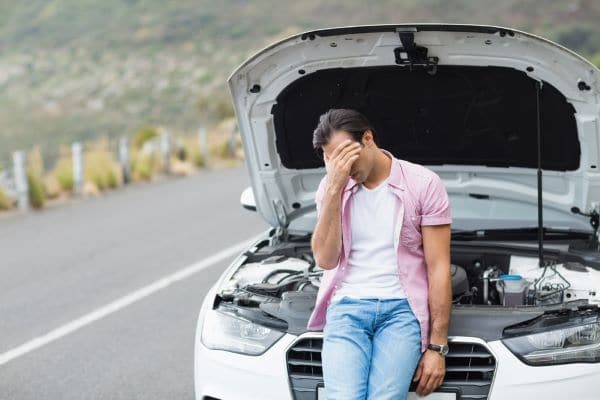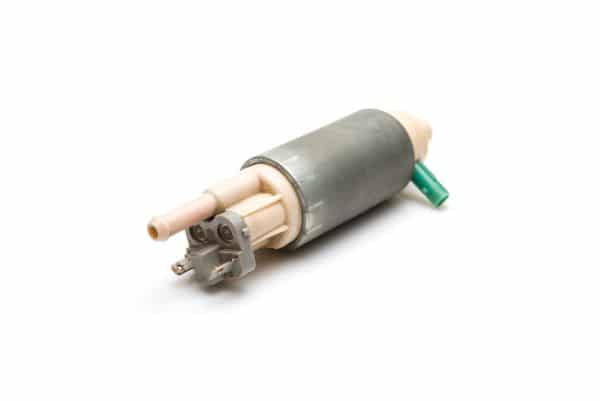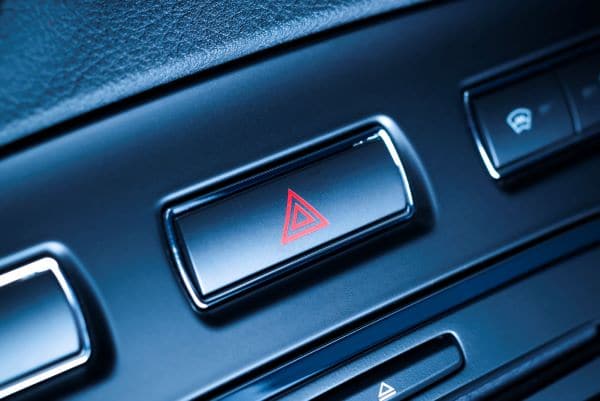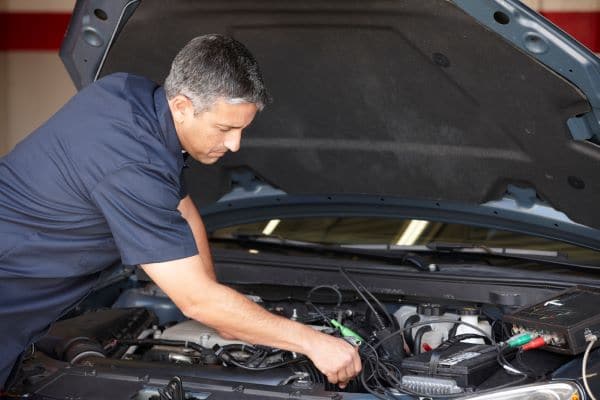When you are driving down the road, you want to know that everything is operating as it should. That’s why it is so frightening if the car died while driving. What would cause a car to shut off while driving and what can be done to prevent it? Even if you aren’t mechanically inclined, you should be able to figure out more about what’s going on.

If your car dies while driving, there are a few things that could be malfunctioning. We look at the top reasons the car shut off while driving and show you what to do next. We also show you how to prevent this scary condition from occurring in the first place.
Table of Contents
Car Dies While Driving: Top 4 Reasons Explained
Whether the car turns off while driving but turns back on or you can’t get it to restart, there are many possible explanations. We will look closer at the top four reasons for the vehicle to die while you are driving it.
Reason #1: Car Battery Died
Can a car battery die while driving? Yes, in fact, this is one of the most common reasons that the car dies while driving. Typically, you think of a dead car battery when the vehicle doesn’t start as you run late for work, but it can also cause trouble as you are heading down the road.

If the car battery died while driving, the alternator needs to take over to power up the electronics and keep the engine running. When the alternator becomes overworked, there is more stress on the car engine and it can quit.
Generally speaking, a good car battery could last you five years if it is properly maintained. However, if you don’t charge it properly, it won’t be able to provide you with as many years of service.
Diagnose Car Battery Died While Driving
The car battery is needed to get the car running. If it dies while you are driving, it won’t cause the engine to stop running on its own; there would need to be other electrical problems occurring. However, it’s important that you recognize the signs of a dead car battery, so you can prevent this from occurring.
If you notice these signs, it might be time to have the car battery checked.
- Engine stalls
- Engine turns over multiple times while starting
- You must jump-start the battery
- Engine struggles to start when it is cold outside
- Exterior lights have gotten dimmer
- Interior lights have gotten dimmer
- Radio works intermittently
- Battery terminals are corroded
- Distilled water level in the cells is low
You can use a multimeter to check the battery charge or take it to an auto parts store for a free evaluation.
Battery Replacement Cost
To keep your vehicle running the way it should, you will need to replace the battery. Depending on the size and brand battery you need, you are looking at a replacement cost ranging from $40 to $300. Thankfully, it’s pretty easy to put a new battery in the car. Here’s a helpful video if you need more guidance.
Reason #2: Alternator Fails
Can a car battery die while driving? Yes, but most likely, you are dealing with a faulty alternator that has stopped charging the battery instead. If the car battery died while driving, consider that the alternator might be to blame, especially if it is a newer battery.

While the car engine runs, the alternator charges the battery. It is also responsible for supplying power to the electrical systems, including the accessories. If you have swapped out the battery, but it continues to die, the alternator has likely failed. Both need to be in optimal condition to start and run your vehicle.
Diagnosing a Failing Alternator
Many of the symptoms of a defective alternator look the same as having a bad battery. These include:
- Car battery continues to die
- Lights and accessories appear to have less power
- Battery charging light comes on dashboard
- Burning smell from under the hood
- Strange sounds
Alternator Replacement Cost
The alternator will be more expensive to replace than most car batteries. On average, you are looking at between $150 and $750 for the alternator, plus the labor to install it. If you drive a premium vehicle, the cost is going to be much higher than if you had a small compact car.
If you are mechanically inclined, you might be able to change the alternator yourself and save some money. Here’s a helpful video illustrating how to change an alternator.
Reason #3: Fuel Pumps Dies
If the car dies while driving but still has power, you know there isn’t necessarily an electrical issue involved. Instead, the issue could be related to your fuel pump. Sometimes, it’s caused by a simple mistake such as filling up with the wrong type of fuel.

Additionally, the fuel pump requires care to keep running. You can maintain your fuel pump by keeping the tank at least half full and changing out the filter regularly.
Diagnosing a Bad Fuel Pump
When the fuel pump starts to fail, you might notice a strange noise when you start the car. You can also look for these symptoms.
- Engine sputters while traveling high speeds
- Decreased fuel pressure
- Less power when the vehicle is dealing with stress
- Trouble accelerating
- Poor fuel economy
- Engine doesn’t start
Fuel Pump Replacement Cost
You can expect to pay between $90 and $900 for a fuel pump, depending on what type of vehicle you drive. If you can’t replace it yourself, labor might also be around $120 to $300. For the most part, replacing a fuel pump is fairly straightforward. Here’s a visual idea of what’s involved.
Reason #4: Out of Fuel
No one ever wants to admit that they ran out of fuel, but it happens. Whether you forgot to fill up or you thought you could make it a little longer, a dying car while you drive could be a lack of fuel. It’s also possible that your fuel gauge isn’t working, causing you to misread what is left in the tank.

Diagnosing Running Out of Fuel
Thankfully, most cars offer a little warning before they run out of fuel. If you notice the signs of fuel starvation early enough, you might be able to get to a filling station before the engine quits. Watch for these signs.
- Empty reading on the fuel gauge
- Engine sputtering
- Intermittent power surging
- Engine backfires
Out of Fuel Cost
If you run out of fuel, you don’t have any major problems other than you need to get gas in the car. With a gas can and a local filling station, you should be back on the road quickly. Additionally, having roadside assistance can help you get a few gallons of fuel delivered to you.
Bonus Reasons Car Dies While Driving
While we’ve covered the top four reasons that your car might die, there are tons more to think about. Sure, the battery, alternator, fuel pump and lack of fuel would be the top reasons, but they aren’t the only ones that could give you trouble.
We’ve also seen ignition system faults, defective speed sensors, bad MAP sensors and an overheated engine stop the vehicle in its tracks. However, these aren’t as common, so not always the first place you should look.
What To Do If Car Shuts Off While Driving
If the car dies while driving, you need to take prompt action to avoid an accident. Your safety and that of others on the road should be your first priority. Here are some tips to follow that will prevent any incidents.

Don’t Panic
With a clear head, you can take quick action. Do not panic, but try to think through your next steps.
Guide the Car Off of the Road
When the car shuts off, you will lose the power brakes and steering systems, but you can still get the vehicle off the road if you act fast. Coast the vehicle and attempt to pull it over in the safest location available. If you are having trouble slowing down, pull the emergency brake slowly. If you can, park as far away from other traffic as you can.
Try to Restart the Engine
You should always try to start the engine back up. However, if the car stalls while driving but starts back up, it doesn’t mean you are in the clear to continue down the road. Instead, you should drive to the nearest repair center to figure out what caused your problem. You don’t want to run into the same situation a few miles down the road.
Use the Emergency Flashers
If you can’t restart the engine, you need to alert other drivers to your car on the road. Use your emergency flashers to gain attention. Hopefully, the courteous drivers will give you as much space as possible and help everyone remain safe.
Get Help
If you have roadside assistance, you can use it now for a free tow. Otherwise, you will need to contact a tow company and get the vehicle moved from the side of the road. Do this quickly to avoid an accident.
How to Fix Car Turns Off While Driving
Depending on what has caused your problem, you might be able to fix it quickly and get back on the road. Minor conditions can cause the engine to shut down, but a fast repair might be all you need. Consider doing these steps to see if you can get back on track.
Check Battery Terminals
If the battery cables aren’t making contact with the battery terminals, it can cause problems starting and running your vehicle. Check to make sure that all of the connections are tight and try restarting your vehicle again. You can also try jumping the car with a battery charger or put a new battery in to see if that fixes the problem.
Check Radiator Water Level
Under the hood towards the front of your car, there is a metal cap on the radiator. Once your vehicle is cooled down for at least 20 minutes, you can remove this cap to check the water levels. You should never touch this when the engine is hot. If there is no water inside, add some and try restarting the vehicle.
Check the Fuses
There’s always a chance that a fuse is blown. You can locate the fuse box under the steering wheel to the left. You can inspect the fuses to see if there are any breaks in the wire. If there is, you will need to replace it with the same fuse.
If none of these easy fixes repairs the situation, you will need more guidance. The problem is likely more complicated and something that can’t be repaired on the side of the road. Take your car to a local service station for more help.
Preventing Car Suddenly Dies While Driving
The good news is that you can prevent a lot of car issues simply by performing regular maintenance and care. If you are paying attention to your service manual recommendations and getting issues repaired promptly, you don’t need to be stranded on the side of the road. Here are a few maintenance tips that might help you out.

Check the Battery
Your battery needs to hold a solid charge to work correctly. Your battery should read between 12.4 and 12.9 volts when the car is not running. With the engine on, it should have a reading of 14 volts because the alternator is charging it.
Check the battery health every season change. When it starts to diminish, it’s time to recondition it or replace it. Additionally, you should be inspecting the battery cables for corrosion and cleaning them as needed. Battery corrosion is easy to clean with some distilled water and baking soda. Just be careful not to get any battery acid on your skin.
Check the Alternator
Alternators are built to last the lifetime of the vehicle, but they aren’t immune from dying. If you have a lot of miles on your vehicle, pay attention to the signs of a failing alternator. By replacing it promptly, you can avoid being broken down. Check id-hurry fake id.
Change Air Filters
As part of a regular tune-up, you should be changing the engine air filter. If the filter becomes clogged, it will cause severe performance problems, even to the point of feeling like the vehicle might stall. Using a dirty air filter can also cause the MAF sensor to fail, which only causes more trouble.
Most air filters should be replaced around every 10,000 miles. Plus, they don’t typically cost more than $20, which is an inexpensive insurance policy.
Change Spark Plugs
Another vital part of the regular tune-up is to change the spark plugs. These vital ignition system components endure a lot of abuse and will foul out, especially when put under heavy loads or while operating in extreme temperatures.
Depending on what type of spark plugs you are using, you might get somewhere between 30,000 and 100,000 miles out of the spark plugs. Most engines contain one spark plug per cylinder, except for a few Dodge models that contain two per cylinder.
FAQs
Can a car battery die while driving?
It’s not impossible for a dead car battery to cause the vehicle to stop, but it’s not always the main reason. Typically, when the car battery dies, the alternator is still running, so you might not notice any trouble while you are driving. However, when the alternator fails, causing the battery to go uncharged, the engine can cease running, leaving you stranded on the side of the road.
What happens if the battery dies while driving?
If the battery fails when you are driving, it’s probably caused by a failing alternator that won’t charge it. If you are driving when this happens, you will notice that the engine cuts out and you lose all power. When this happens, you have only seconds to figure out how to get off the road. You will also lose power steering and braking, making it even more difficult to maneuver the vehicle to a safe location. Don’t panic and make a rational decision to ensure your safety.
What does it mean if the car dies while driving but restarts?
If the car dies while you are driving but is able to restart, you might be facing numerous malfunctions. It could be due to an issue with the charging system, a loose timing belt, a lack of fuel or something with the fuel system. It could also be because the engine has overheated. Even if you can get the engine started back up, you should have the vehicle looked at right away to avoid any future trouble.
Conclusion
It’s not a fun experience to deal with a car dying while driving, but it happens. By taking good care of your vehicle, you can avoid future issues and prepare yourself for the worst-case scenario. A little preparation goes a long way and helps to ensure your safety while driving. Take care of your vehicle so it can continue to provide you with many years of service.
